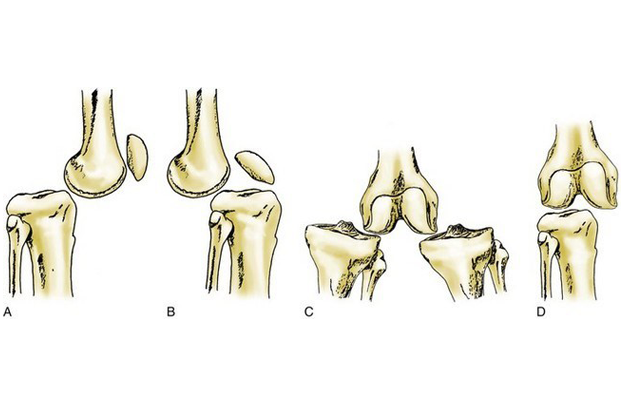
Is your knee in distress? Know if it’s a fracture, dislocation, or something else causing it. Common Types of Knee Injuries
Did you fall down or hear a sudden pop in your knee while jumping? Are you experiencing a great deal of pain and stiffness in your knee? Is it swollen and can’t be bent fully? It seems you have injured your knee or you need post knee injury rehabilitation. Not surprisingly, knee injuries are very common among both athletes and nonathletes. Although knee injuries are highly likely to happen during collisions, accidents, and falls, people with weakened knees joints could also face knee injuries while engaging in minimal stress activities such as running, jumping, exercising, etc. In case your knee has lost is regular motion and is painful, you should seek immediate medical help. Here are different common knee injury types
Fracture
Knee fracture is one of the most painful injuries that a human being can suffer. It involves breaking or cracking of one or a combination of three types of knee bones, Tibia, patella, and femur. Based on the fracture of a knee bone type, knee fractures are classified as patella (kneecap) fracture, femoral condyle fracture or tibial fracture.
Patella fractures occur when the knee is positioned in a semi-flexed position and it gets a direct blow by an object during a collision or accidental fall.
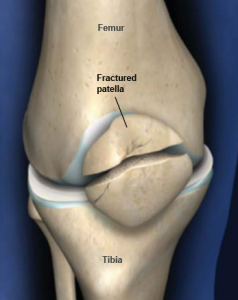
Femoral condyle fractures are caused when the two bone ends of femur experience high impact force. It commonly occurs when a person jumps from great heights. Often femoral knee fractures occur in conjunction with other types of knee fractures, as femoral condyles are the key supporting bones in the knee. In extreme cases, the bones can pierce out of the skin and cause internal bleeding.
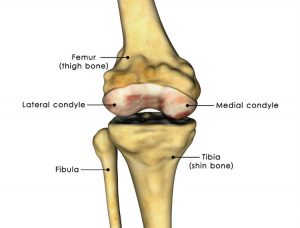
Tibia fractures are associated with the breaking of shinbone or tibia, which is a long bone that runs below the patella and joins the ankle below. This fracture type is least common, as it requires a major force to break the long bone. Inability to bear weight, severe shooting pain, protruding bone from the skin, and loss of sensation are some of the symptoms of tibia fractures. Depending on the extent of the fracture, it can be called a stable (bones line up correctly and stay in place while healing), displaced (broken ends do not line up) or comminuted fracture (bones are shattered into pieces). Also, depending on the fracture line, a tibia fracture can be a transverse fracture, an oblique fracture, or a spiral fracture.
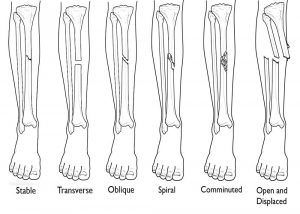
Dislocation
Knee dislocation occurs when the ligaments stabilizing the knee bones tear and put them out of place. These rarely happen because of high-speed impact during car crashes and falls. A dislocated knee joint fills with fluid, swells and gets inflammation. It is painful and the person is disabled of any movement. In severe cases, there can be the loss of feeling or pulse below the knee.
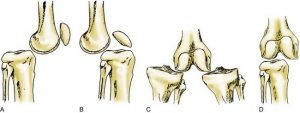
Anterior Cruciate Ligament (ACL) Injury
Anterior Cruciate Ligament is one of three key ligaments that supports and holds tibia and femur in the knee joint together. When the ACL gets stretched, completely or partially torn, it leads to ACL injury. While the injury occurs, the person might hear a popping sound. Joint swelling, severe pain, and unstable knee are the common symptoms of ACL injury.
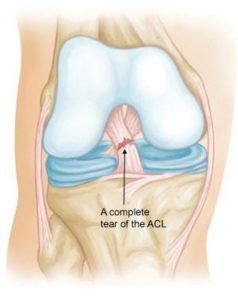
Posterior Cruciate Ligament (PCL) Injury
PCL knee injury occurs when the knee is bent and gets a sudden blow. Falling on the bent knee or a powerful blow due to a collision while in a seated position can cause PCL injury. The chances of getting a PCL injury is lesser than an ACL injury as thickness and strength of PCL is greater than ACL. Stiffness, pain and tibial sagging are some of the major symptoms of PCL injury.
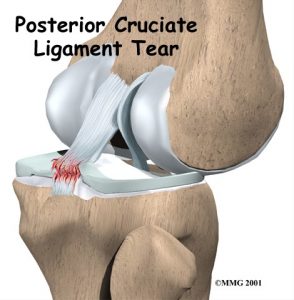
Lateral Collateral Ligament (LCL) Injury
The collateral ligament that originates from the lateral femoral epicondyle connects the femur to the tibia in the knee joint. It keeps the knee stable and controls its sideway motions. LCL injury is least common compared to other knee ligament injuries. It happens when the knee gets a blow on its inner side and leads to tearing of LCL It usually occurs in combination with damage to the meniscus, ACL, and PCL. LCL tear symptoms include knee swelling, tenderness, pain and knee instability.
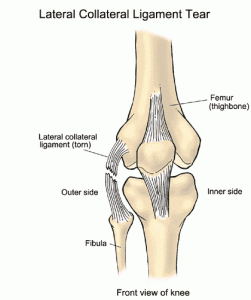
Meniscal Tear
The meniscus is two wedge-shaped cartilage structure that acts as a shock absorber or rubbery cushion in the knee. It resides between the shinbone and thighbone and prevents their wearing. This injury can happen to people involved in contact sports such as soccer, football, ice hockey, wrestling, basketball etc. Also, older people are likely to suffer from meniscus tears because of their wearing and weakening over time. Symptoms of meniscal tears include swelling, pain, stiffness, locking of the knee, and sensation of knee joints coming apart.

Tendon Tear
Knees have the patellar tendon which is a fibrous tissue made of strong cords. It attaches the patella to the top of the tibia. Direct impact on the knee’s frontal portion during falls and jumping can cause tearing of the patellar tendon. Based on the extent of the tear, tendon tears can be partial or complete. In case of partial tears, some of the fibers in the cord are frayed but the tendon remains intact. On the other hand, complete tears involve fully torn tendon that detaches the bone and the kneecap. People with conditions such as rheumatoid arthritis, diabetes mellitus, hyperbetalipoproteinemia, and SLE are prone to suffering tendon tears.

Although RICE is helpful to relieve some pain and discomfort, a person with a knee injury needs immediate medical attention from an orthopedist. After the recovery, under the supervision of a physiotherapist, performing knee rehabilitation exercises is crucial to regain motion and get back to active lifestyle.
We at Rapid Physiocare have guided hundreds of people with rehabilitation exercises to quickly recover from different types of knee injuries. Our physios will suggest you exercises that are easy to perform and are effective in building strength, coordination, agility and core stability in the recovered knee joint. Book an appointment today to ensure full recovery of your knee.






